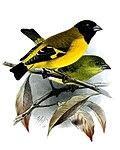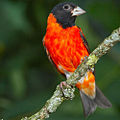Superregnum: Eukaryota
Regnum: Animalia
Subregnum: Eumetazoa
Cladus: Bilateria
Cladus: Nephrozoa
Superphylum: Deuterostomia
Phylum: Chordata
Cladus: Craniata
Subphylum: Vertebrata
Infraphylum: Gnathostomata
Superclassis: Tetrapoda
Cladus: Reptiliomorpha
Cladus: Amniota
Classis: Reptilia
Cladus: Eureptilia
Cladus: Romeriida
Subclassis: Diapsida
Cladus: Sauria
Infraclassis: Archosauromorpha
Cladus: Crurotarsi
Divisio: Archosauria
Subsectio: Ornithodira
Subtaxon: Dinosauromorpha
Cladus: Dinosauria
Ordo: Saurischia
Cladus: Theropoda
Cladus: Neotheropoda
Infraclassis: Aves
Ordo: Passeriformes
Subordo: Passeri
Infraordo: Passerida
Superfamilia: Passeroidea
Familia: Fringillidae
Subfamilia: Carduelinae
Genus: Spinus
Species: S. atratus – S. atriceps – S. barbatus – S. crassirostris – S. cucullatus – S. dominicensis – S. lawrencei – S. magellanicus – S. notatus – S. olivaceus – S. pinus – S. psaltria – S. siemiradzkii – S. spinescens – S. spinus – S. thibetanus – S. tristis – S. uropygialis – S. xanthogastrus – S. yarrellii
Name
Spinus Koch, 1816
Typus
Spinus viridia Koch 1816 = Spinus spinus Linnaeus, 1758
Synonyms
Chrysomitris Boie, 1828
References
Primary references
Syst. Baierischen Zool. 1: 232, pl. 6, fig. 52.
References
Zuccon, D., Prŷs-Jones, R., Rasmussen, P.C., & Ericson, P.G.P. 2012. The phylogenetic relationships and generic limits of finches (Fringillidae). Molecular Phylogenetics and Evolution 62 (2): 581–596. Full text (PDF). DOI: .1016/j.ympev.2011.10.002 Reference page.
Vernacular names
English: Siskins
español: Jilgueros
Spinus is a genus of passerine birds in the finch family. It contains the North and South American siskins and goldfinches, as well as two Old World species. The genus name is from the Ancient Greek σπίνος spínos, a name for a now-unidentifiable bird.[1]
All of the species in the genus, except for the Tibetan serin, were formerly included in the genus Carduelis. They were moved to the resurrected genus Spinus based on phylogenetic studies of mitochondrial and nuclear DNA sequences.[2][3][4] The Tibetan serin was formerly placed in the genus Serinus. The Eurasian siskin and the Tibetan serin are the only species from the Old World included in the group.[2]
The genus Spinus was introduced in 1816 by the German naturalist Carl Ludwig Koch with the Eurasian siskin (Spinus spinus) as the type species.[5][6]
Evolution and phylogeny
The Tibetan serin is an outgroup within Spinus, having been the first to diverge.[3] The remainder of the genus can be divided into three monophyletic clades: the North American goldfinches (Lawrence's, lesser, and American); the so-called North American siskins (Eurasian, pine, Antillean, and black-capped); and the South American siskins (the remaining 12 species).[7]
The radiation of South American siskins was rapid, and was originally thought to have occurred around 3.5 million years ago due to a range expansion associated with the Great American Interchange and contingent upon the spread of mesothermal plants from the Rocky Mountains to the Andes.[7]More recent work suggests the radiation occurred much later, within the last 1 million years, and speciation events may have been initiated by the climactic variations of the late Pleistocene.[8]
The hooded siskin may be paraphyletic.[8]
Ecology
Spinus finches are gregarious and may breed and forage in small groups.[9] In the non-breeding season, these species generally disperse away from the breeding grounds and small flocks roam nomadically in search of food; these flocks may be of one species or mixed with other species in the genus. Some species, such as the pine siskin and thick-billed siskin, are considered irruptive.[9][10]
Like most other members of Carduelinae, but unusually amongst songbirds, members of Spinus are primarily granivorous, but may occasionally supplement their diet with insects or fruit. Most species eat a variety of small seeds, especially from asters, grasses, alders, and birches.[9]
Conservation
The IUCN lists 17 species as least concern, two as vulnerable (saffron siskin and yellow-faced siskin), and one, the red siskin, as endangered. Species in this clade are threatened by habitat loss and capture for the cage-bird trade.[11]
Species
The genus contains 20 species:[2]
| Image | Common name | Scientific name | Distribution |
|---|---|---|---|
 |
Tibetan serin | Spinus thibetanus | Bhutan, China, India, Myanmar, and Nepal |
 |
American goldfinch | Spinus tristis | mid-Alberta to North Carolina during the breeding season, and from just south of the Canada–United States border to Mexico during the winter |
 |
Lawrence's goldfinch | Spinus lawrencei | California and Baja California, winters in the southwestern United States and northern Mexico |
 |
Lesser goldfinch | Spinus psaltria | the southwestern United States (near the coast, as far north as extreme southwestern Washington) to Venezuela and Peru |
 |
Eurasian siskin | Spinus spinus | Eurasia and North Africa |
 |
Antillean siskin | Spinus dominicensis | Hispaniola (Haiti and the Dominican Republic) |
 |
Pine siskin | Spinus pinus | Canada, Alaska and, to a more variable degree, across the western mountains and northeastern parts of the United States |
 |
Black-capped siskin | Spinus atriceps | Mexico and Guatemala |
 |
Black-headed siskin | Spinus notatus | Mexico, Belize, El Salvador, Guatemala, Honduras, and Nicaragua |
 |
Black-chinned siskin | Spinus barbatus | Chile, Argentina and the Falkland Islands |
 |
Yellow-bellied siskin | Spinus xanthogastrus | Costa Rica south to southern Ecuador, central Bolivia and the highlands of northwestern Venezuela |
 |
Olivaceous siskin | Spinus olivaceus | northern Peru to La Paz and Cochabamba in Bolivia and to southeastern Ecuador; has also been observed east of the Andes near Santa Cruz de la Sierra in Bolivia |
 |
Hooded siskin | Spinus magellanicus | central Argentina north to central Brazil |
 |
Saffron siskin | Spinus siemiradzkii | Ecuador and Peru |
 |
Yellow-faced siskin | Spinus yarrellii | Brazil and Venezuela |
 |
Red siskin | Spinus cucullatus | northern Colombia and northern Venezuela |
 |
Black siskin | Spinus atratus | Chile, Argentina, Bolivia and Peru |
 |
Yellow-rumped siskin | Spinus uropygialis | Chile, Argentina, Bolivia and Peru |
| Thick-billed siskin | Spinus crassirostris | Chile, Argentina, Bolivia and Peru | |
 |
Andean siskin | Spinus spinescens | Colombia, Ecuador and Venezuela |
References
Jobling, James A. (2010). The Helm Dictionary of Scientific Bird Names. London, United Kingdom: Christopher Helm. p. 362. ISBN 978-1-4081-2501-4.
Gill, Frank; Donsker, David (eds.). "Finches, euphonias". World Bird List Version 5.2. International Ornithologists' Union. Retrieved 5 June 2015.
Zuccon, Dario; Prŷs-Jones, Robert; Rasmussen, Pamela C.; Ericson, Per G.P. (2012). "The phylogenetic relationships and generic limits of finches (Fringillidae)" (PDF). Molecular Phylogenetics and Evolution. 62 (2): 581–596. doi:10.1016/j.ympev.2011.10.002. PMID 22023825.
Nguembock, B.; Fjeldså, J.; Couloux, A.; Pasquet, E. (2009). "Molecular phylogeny of Carduelinae (Aves, Passeriformes, Fringillidae) proves polyphyletic origin of the genera Serinus and Carduelis and suggests redefined generic limits". Molecular Phylogenetics and Evolution. 51 (2): 169–181. doi:10.1016/j.ympev.2008.10.022. PMID 19027082.
Koch, Carl Ludwig (1816). System der baierischen Zoologie, Volume 1 (in German). Nürnberg. p. 232.
Paynter, Raymond A. Jr, ed. (1968). Check-list of Birds of the World. Volume 14. Cambridge, Massachusetts: Museum of Comparative Zoology. p. 234.
"ResearchGate". ResearchGate. doi:10.2174/1874453201205010073. Retrieved 2021-01-20.
Beckman, Elizabeth J.; Witt, Christopher C. (2015-06-01). "Phylogeny and biogeography of the New World siskins and goldfinches: Rapid, recent diversification in the Central Andes". Molecular Phylogenetics and Evolution. 87: 28–45. doi:10.1016/j.ympev.2015.03.005. ISSN 1055-7903.
Clement, Peter (2010-08-30). Finches and Sparrows. A&C Black. ISBN 978-1-4081-3530-3.
"Pine Siskin". BirdWeb. Retrieved 2021-01-20.
"The IUCN Red List of Threatened Species". IUCN Red List of Threatened Species. Retrieved 2021-01-21.
Retrieved from "http://en.wikipedia.org/"
All text is available under the terms of the GNU Free Documentation License

